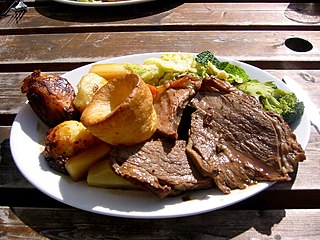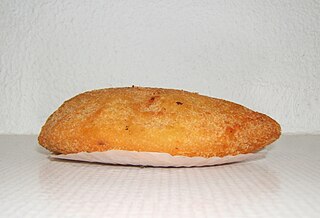
The cuisine of the American Midwest draws its culinary roots most significantly from the cuisines of Central, Northern and Eastern Europe, and Indigenous cuisine of the Americas, and is influenced by regionally and locally grown foodstuffs and cultural diversity.

Tempura is a typical Japanese dish that usually consists of seafood and vegetables that have been coated in a thin batter and deep fried.

A Sunday roast or roast dinner is a traditional meal of British origin. Although it can be consumed throughout the week, it is traditionally consumed on Sunday. It consists of roasted meat, roasted potatoes, mashed potatoes and accompaniments such as Yorkshire pudding, stuffing, gravy, and condiments such as apple sauce, mint sauce, or redcurrant sauce. A wide range of vegetables can be served as part of a roast dinner, such as broccoli, Brussels sprouts, cabbage, carrots, cauliflower, parsnips, or peas, which can be boiled, steamed, or roasted alongside the meat and potatoes.

Polish cuisine is a style of food preparation originating in and widely popular in Poland. Due to Poland's history, Polish cuisine has evolved over the centuries to be very eclectic, and shares many similarities with other national cuisines. Polish cooking in other cultures is often referred to as à la polonaise.

Danish cuisine originated from the peasant population's own local produce and was enhanced by cooking techniques developed in the late 19th century and the wider availability of goods during and after the Industrial Revolution. Open sandwiches, known as smørrebrød, which in their basic form are the usual fare for lunch, can be considered a national speciality when prepared and garnished with a variety of ingredients. Hot meals are typically prepared with meat or fish. Substantial meat and fish dishes includes flæskesteg and kogt torsk with mustard sauce and trimmings. Ground meats became widespread during the industrial revolution and traditional dishes that are still popular include frikadeller, karbonader and medisterpølse. Denmark is known for its Carlsberg and Tuborg beers and for its akvavit and bitters, but amongst the Danes themselves imported wine has gained steadily in popularity since the 1960s.

A schnitzel is a thin slice of meat. The meat is usually thinned by pounding with a meat tenderizer. Most commonly, the meat is breaded before frying. Breaded schnitzel is popular in many countries and is made using veal, pork, chicken, mutton, beef, or turkey. Schnitzel originates in Austria as wiener schnitzel and is very similar to dishes such as escalope in France and Spain, panado in Portugal, tonkatsu in Japan, cotoletta in Italy, kotlet schabowy in Poland, řízek in Czech Republic, milanesa in Latin America, chuleta valluna in Colombia, chicken chop in Malaysia, and chicken-fried steak and pork tenderloin of the United States.

A rissole is a small patty enclosed in pastry or rolled in breadcrumbs, usually baked or deep fried. The filling has savory ingredients, most often minced meat, fish or cheese, and is served as an entrée, main course, or side dish.
The Friday fast is a Christian practice of variously abstaining from meat, dairy products and alcohol, on Fridays, or holding a fast on Fridays, that is found most frequently in the Eastern Orthodox, Oriental Orthodox, Catholic, Lutheran, Anglican and Methodist traditions. The Teaching of the Twelve Apostles, written in the first century A.D., directed Christians to fast on both Wednesdays and Fridays. The Wednesday fast is done in remembrance of the story of the betrayal of Christ by Judas on Spy Wednesday, while the Friday fast is done in commemoration of the crucifixion of Jesus Christ on Good Friday. As such, all Fridays of the year have been historically kept in many parts of Christendom as a day of strict fasting and abstinence from alcohol, meat and lacticinia. Abstinence from meat on Fridays is done as a sacrifice by many Christians because they believe that on Good Friday, Jesus sacrificed his flesh for humanity. In the Eastern Orthodox Church, in addition to fasting from food until sundown, the faithful are enjoined to abstain from sexual relations on Fridays as well.
Cutlet refers to:
- a thin slice of meat from the leg or ribs of mutton, veal, pork, or chicken
- a dish made of such slice, often breaded
- a croquette or cutlet-shaped patty made of ground meat
- a kind of fish cut where the fish is sliced perpendicular to the spine, rather than parallel ; often synonymous with steak
- a prawn or shrimp with its head and outer shell removed, leaving only the flesh and tail
- a mash of vegetables fried with bread

A crab cake is a variety of fishcake popular in the United States. It is composed of crab meat and various other ingredients, such as bread crumbs, mayonnaise, mustard, eggs, and seasonings. It is then sautéed, baked, grilled, deep fried, or broiled. Crab cakes are traditionally associated with the Chesapeake Bay, in the state of Maryland. Although the earliest use of the term "crab cake" is commonly believed to date to Crosby Gaige's 1939 publication New York World's Fair Cook Book in which they are described as "Baltimore crab cakes," earlier usages can be found such as in Thomas J. Murrey's book Cookery with a Chafing Dish published in 1891.

The Catholic Church historically observes the disciplines of fasting and abstinence at various times each year. For Catholics, fasting is the reduction of one's intake of food, while abstinence refers to refraining from something that is good, and not inherently sinful, such as meat. The Catholic Church teaches that all people are obliged by God to perform some penance for their sins, and that these acts of penance are both personal and corporeal. Bodily fasting is meaningless unless it is joined with a spiritual avoidance of sin. Basil of Caesarea gives the following exhortation regarding fasting:
Let us fast an acceptable and very pleasing fast to the Lord. True fast is the estrangement from evil, temperance of tongue, abstinence from anger, separation from desires, slander, falsehood and perjury. Privation of these is true fasting.

Uruguayan cuisine is a fusion of cuisines from several European countries, especially of Mediterranean foods from Spain, Italy, Portugal and France. Other influences on the cuisine resulted from immigration from countries such as Germany and Scotland. Uruguayan gastronomy is a result of immigration, rather than local Amerindian cuisine, because of late-19th and early 20th century immigration waves of, mostly, Italians. Spanish influences are abundant: desserts like churros, flan, ensaimadas yoo (Catalan sweet bread), and alfajores were all brought from Spain. There are also all kinds of stews known as guisos or estofados, arroces, and fabada. All of the guisos and traditional pucheros (stews) are also of Spanish origin. Uruguayan preparations of fish, such as dried salt cod (bacalao), calamari, and octopus, originate from the Basque and Galician regions, and also Portugal. Due to its strong Italian tradition, all of the famous Italian pasta dishes are present in Uruguay including ravioli, lasagne, tortellini, fettuccine, and the traditional gnocchi. Although the pasta can be served with many sauces, there is one special sauce that was created by Uruguayans. Caruso sauce is a pasta sauce made from double cream, meat, onions, ham and mushrooms. It is very popular with sorrentinos and agnolotti. Additionally, there is Germanic influence in Uruguayan cuisine as well, particularly in sweet dishes. The pastries known as bizcochos are Germanic in origin: croissants, known as medialunas, are the most popular of these, and can be found in two varieties: butter- and lard-based. Also German in origin are the Berlinese known as bolas de fraile, and the rolls called piononos. The facturas were re-christened with local names given the difficult German phonology, and usually Uruguayanized by the addition of a dulce de leche filling. Even dishes like chucrut (sauerkraut) have also made it into mainstream Uruguayan dishes.

Abstinence is the practice of self-enforced restraint from indulging in bodily activities that are widely experienced as giving pleasure. Most frequently, the term refers to sexual abstinence, but it can also mean abstinence from alcohol, drugs, food, or other comforts.

Lent is the solemn Christian religious observance in the liturgical year commemorating the 40 days Jesus spent fasting in the desert and enduring temptation by Satan, according to the Gospels of Matthew, Mark and Luke, before beginning his public ministry. Lent is usually observed in the Catholic, Lutheran, Moravian, Anglican, United Protestant and Orthodox Christian traditions, among others. Some Anabaptist, Baptist, Methodist, Reformed, and nondenominational Christian churches also observe Lent, although many churches in these traditions do not.

The cuisine of Minnesota is a type of Midwestern cuisine found throughout the state of Minnesota.

A croquette is a deep-fried roll originating in French cuisine, consisting of a thick binder combined with a filling, which is then breaded. It is served as a side dish, a snack, or fast food worldwide.

Breaded cutlet or braised cutlet is a dish made from coating a cutlet of meat with breading or batter and either frying or baking it.
Barbadian cuisine, also called Bajan cuisine, is a mixture of African, Portuguese, Indian, Irish, Creole, Indigenous and British background. A typical meal consists of a main dish of meat or fish, normally marinated with a mixture of herbs and spices, hot side dishes, and one or more salads. The meal is usually served with one or more sauces.

A Lenten supper is a meal that takes place in the evenings to break the day's fast during the Christian liturgical season of Lent, which is widely observed by members of the Catholic, Lutheran, Moravian, Anglican, Methodist, and United Protestant traditions, in addition to certain Reformed denominations.

















